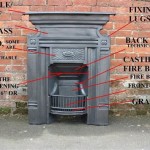How To Build A Dry Stack Stone Fireplace
A dry stack stone fireplace presents a visually appealing and structurally sound centerpiece for both indoor and outdoor spaces. This method of construction, relying on the inherent weight and friction of the stones rather than mortar for stability, requires careful planning and execution. This article provides a comprehensive guide to constructing a dry stack stone fireplace, addressing key considerations and outlining the necessary steps.
Before commencing construction, it's crucial to ensure the proposed fireplace complies with local building codes and regulations. This may involve obtaining permits and adhering to specific guidelines regarding fire safety, chimney height, and proximity to combustible materials. Consult with your local building department to determine the specific requirements for your area.
Choosing the right type of stone is paramount to the longevity and aesthetic appeal of the fireplace. The stone should be durable, weather-resistant, and of a consistent size and shape to facilitate stable stacking. Common choices include fieldstone, sandstone, and limestone. It's advisable to source stones from a reputable supplier, ensuring they are free from cracks, fractures, or other defects. The quantity of stone needed will depend on the dimensions of the fireplace; it is invariably wise to order a buffer quantity to cater for breakages and selection needs.
Planning and Preparation
The foundation is the bedrock of any dry stack stone fireplace. A solid, level foundation is essential for distributing the weight of the structure and preventing settling or shifting over time. The foundation should extend beyond the footprint of the fireplace itself, providing ample support. Typically, a concrete slab foundation is recommended for its stability and durability. The ground should be properly excavated, compacted, and reinforced with rebar before pouring the concrete. The slab must be allowed to cure completely before construction begins.
The dimensions of the fireplace will dictate the amount of materials required and the complexity of the construction process. Before beginning to stack stones, it is essential to map out the footprint and height of the fireplace, including details like the size of the firebox, chimney dimensions, and any decorative features you plan to incorporate. Accurate measurements and detailed sketches will prove indispensable as the build progresses.
Tools required for this project include a level (both standard and laser levels are useful), rubber mallet, chisels, safety glasses, work gloves, pry bar (for moving heavier stones), measuring tape, and a wheelbarrow for transporting materials. A masonry saw may be needed for cutting stones to achieve the desired dimensions and fit. Ensure all tools are in good working order before starting the construction process.
The Construction Process
The construction of a dry stack stone fireplace commences by creating a stable base layer. The largest and flattest stones should be selected for this purpose, ensuring they are properly seated and level. The stones should interlock wherever possible, creating a strong and unified foundation. Any gaps or voids can be filled with smaller stones or gravel to enhance stability.
As the construction progresses, maintaining consistent courses of stone is pivotal. Using the level frequently, ensure each layer of stone is horizontal, preventing the fireplace from leaning or becoming unstable. Stagger the joints between stones to maximize strength and mimic the natural arrangement of stone formations. This also prevents straight vertical joints, which can weaken the structure.
The fireplace firebox is constructed with fire-resistant materials. Firebrick is the most commonly used material to withstand the high temperatures generated by the fire. Care must be taken to ensure the firebrick is properly installed and sealed, preventing heat from escaping into the surrounding stonework. A smoke chamber, situated above the firebox, facilitates the proper venting of combustion gases. This chamber should be carefully designed and constructed to ensure adequate draft and prevent smoke from backing up into the room.
The chimney is a crucial component of the fireplace, responsible for drawing combustion gases away from the firebox and releasing them into the atmosphere. The chimney should be constructed of a fire-resistant material, such as firebrick or a stainless-steel flue liner designed for fireplaces. The height of the chimney must be sufficient to create adequate draft, and it should be positioned to avoid obstructions that could impede airflow. Building codes often dictate the minimum chimney height in relation to the roofline and surrounding structures.
Stability and Safety Considerations
Dry stacking stone relies upon gravity and friction to create a stable structure, so the correct arrangement of the stones is very important. Larger, heavier stones should preferentially be positioned towards the bottom of the fireplace, providing a strong and stable base. The stones should be interlocked and angled in such a way that their weight is distributed evenly across the structure. Any gaps between the stones can be filled with smaller stones to enhance stability, but care should be taken to avoid forcing stones into place as this may cause them to crack or fracture. The overall stability of the structure should be continuously monitored as construction progresses.
Drainage is an important consideration. Water infiltration can weaken the structure of a dry stack stone fireplace over time, especially in climates that experience freeze-thaw cycles. Providing adequate drainage around the base of the fireplace is essential to prevent water from accumulating and seeping into the stonework. A French drain or gravel bed can be installed to facilitate water runoff. In addition, consider using a water-repellent sealant on the exterior stones to minimize water absorption. This should be a breathable sealant that allows the stone to ‘breathe’ and dry out as it will inevitably get wet at some stage.
Fire safety is, of course, a paramount concern when constructing a fireplace. Maintaining appropriate clearances between the fireplace and any combustible materials is essential to prevent fire hazards. Building codes specify minimum clearance distances, which must be strictly adhered to. In addition, a spark arrestor should be installed on the chimney to prevent embers from escaping and potentially igniting nearby vegetation. The surrounding area should be kept clear of flammable materials such as leaves, brush, and firewood.
Ongoing maintenance is crucial for ensuring the longevity and safety of the dry stack stone fireplace. Regularly inspect the stonework for any signs of shifting, cracking, or water damage. Any loose or damaged stones should be replaced or repaired promptly. The chimney should be cleaned annually to remove creosote buildup, which is a flammable residue that can accumulate in the flue. In areas with high winds, it's advisable to secure the top of the chimney with a chimney cap or spark arrestor to prevent debris from entering and clogging the flue.
In summary, building a dry stack stone fireplace involves careful planning, meticulous construction, and ongoing maintenance. By adhering to best practices and prioritizing safety, it is possible to construct a functional and aesthetically pleasing fireplace that will provide enjoyment for years to come. Consulting with experienced masons or contractors may be beneficial to ensure the project is completed successfully.

How To Build An Outdoor Stacked Stone Fireplace

Tips On How To Build A Stone Fireplace Horizon

Dry Stack Stone Fireplaces Superb Craftsmanship Centuries In The Making

Dry Stack Vs Mortar Joints The Cultured Stoners

Stacked Stone Fireplace How To Diy

Dry Stack Vs Mortar Joints The Cultured Stoners

Thin Stone Veneers Make A Fireplace Update Easy Swenson Granite 100 Natural Stones

Living Stone Masonry Stonetutorials

Build A Stone Fireplace Resources To Help You Stack It Up Outdoors

Build A Stone Fireplace Resources To Help You Stack It Up Outdoors
Related Posts








